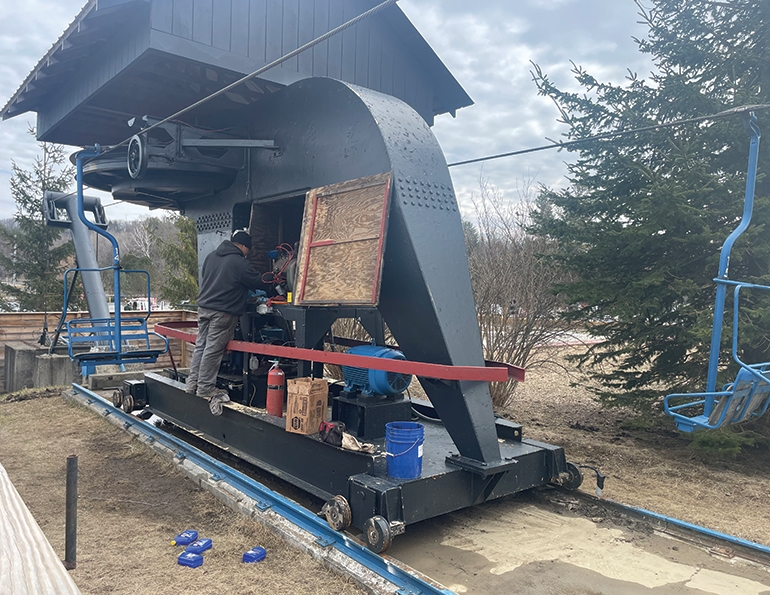There are many factors to consider when deciding whether to repair or replace an aging ski lift. Some are emotional. Some are monetary. Others are functional. Our lifts are part of the identity of our resorts, and it can be hard to say goodbye to a beloved lift.
An old lift may add to a resort’s charm or be a key feature in many guests’ favorite memories. But maybe it is no longer efficient, or the parts needed for repairs to it are less readily available. There is also the question of whether a lift is still safe.
The decision to repair or replace an old lift is complicated, but ultimately, it comes down to the question, “What is best for my resort—both in terms of operations and guest experience?”
To help answer this question, though, there are several more specific factors to consider.
A CASE STUDY: BOUSQUET
Bousquet Mountain, a 200-acre ski area in the Berkshires (Mass.), is currently weighing the options to replace its Blue Chair, a center-pole Hall double that serves the ski area’s beginner and intermediate terrain.
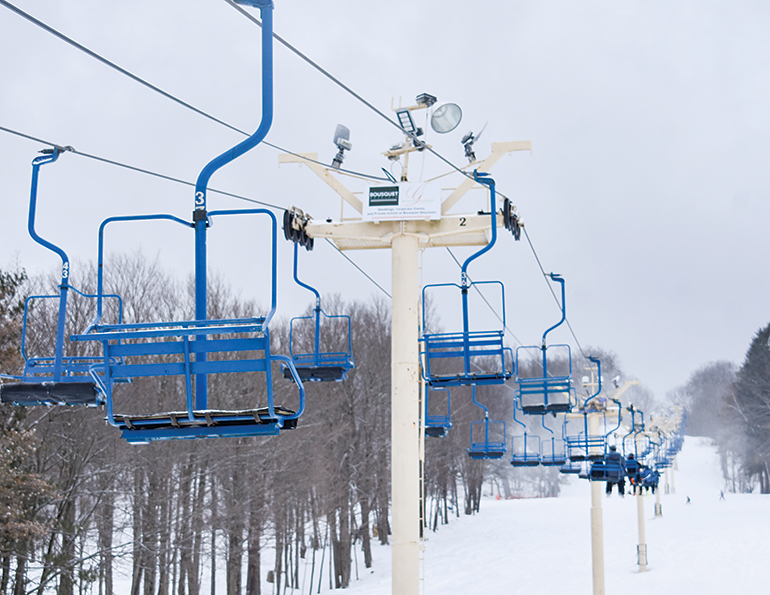 The Blue Chair serves key beginner terrain, so it must reliably operate.
The Blue Chair serves key beginner terrain, so it must reliably operate.
Safety first. Of paramount concern for Bousquet general manager Kevin McMillian is safety. “We can’t operate the lift if we’re worried about safety,” says McMillian. “We trust our maintenance team to address the concerns of the lift’s operation in a timely manner. But if the lift’s safety is a concern, we either need to be able to address those issues or replace the lift, whichever makes the most sense.”
Your state or insurance inspector may make that decision for you. If you cannot fix a specific safety issue, you will need to replace the lift or remove it from service. Risking the safety of guests is just not acceptable.
Orphan lift. While the Blue Chair can be operated safely, the limited availability of replacement parts for it is a major factor in the decision to replace the lift. With Hall Ski Lifts no longer in operation, the Blue Chair, which was installed in the ’80s, is what you’d call an orphan lift. As such, finding basic replacement parts for it—parts that would be readily available for a modern lift—has proved challenging. One such hunt for needed parts led to the lift being closed for several days last winter.
The Blue Chair provides sole access to the only continuous green run down the mountain. When it is on maintenance hold, that’s a problem for beginner skiers and riders, which is a problem for Bousquet as a small area that welcomes many beginners. For management, being able to reliably open the Blue Chair is crucial.
Capacity and other opportunities. Replacing the Blue Chair also presents Bousquet with the opportunity to increase capacity and, more broadly, redesign its base area. These considerations serve as additional contributing factors in the replacement decision.
The lift is a bottom drive with a counterweight tension terminal, which has a large footprint that limits the size of Bousquet’s beginner learning area. Replacing the lift with a modern fixed-grip—the drive terminals for which are often built on a monopod column and have hydraulic tension systems, minimizing their footprint—would give Bousquet the opportunity to expand the size of the beginner hill, and solve the current lift’s reliability issues as well.
Bousquet is not alone in needing to assess the future of its aging lift. Here’s a rundown of how to go about assessing yours.
ASSESSING YOUR LIFT
It is important to understand that, with so many lift manufacturers having gone out of business—Lift Engineering, Hall, Riblet, Borvig, and CTEC, to name a few—sourcing all the parts required for repairs to an old unit can be very complicated.
For example, Yanek Kunczynski of Lift Engineering, aka Yan, built the gearboxes in-house for most of his fixed grips. So, finding parts for a Yan gearbox generally requires searching through old bone yards, which can be very time consuming, or custom fabrication, which can be both time consuming and expensive.
Not all orphan lifts are unsupported. Superior Tramway Co., Partek Ski Lifts, All Ski Lifts, Sky-Trans Manufacturing, and Skytrac Services are some of the companies offering service and parts for lifts from these defunct manufacturers. That said, lifts of certain vintages (models, years, etc.) may be rarer than others, and the aftermarket support for those lifts can be more difficult to find. Support availability is a key factor in whether to repair, upgrade, or replace.
Lifts are complex machines, with several different systems working together. While we need to look at the lift as a whole, breaking down your assessment by system can help in decision making.
Electrical and hydraulic systems are often a concern for an aging lift. Your lift may have a drive that is no longer supported by a manufacturer when repairs are needed. Or you may be having phantom tower faults that come and go on their own, possibly caused by a worn-out comm line.
Andy Pierce of AP Electrical Services suggests that electrical problems can often be solved without the need to replace the entire lift. “On the electrical and even hydraulic side, most issues can be addressed with an upgrade to those systems,” says Pierce. Replacing a comm line can be a solution to a lot of problems. So can upgrading the entire drive and low voltage control system to include modern safeties. If a lift is mechanically sound, choosing to upgrade an electrical or hydraulic system can extend its service life as well.
Mechanical systems. “The breaking point I am most concerned with is on the mechanical side,” says Pierce. Gear boxes, chairs and grips, terminal alignment, and tower equipment are some of the mechanical components that can fail on a lift. While preventative maintenance can ensure that most of an older lift’s parts are in working order, these will eventually fail due to age. Identifying mechanical problems and/or upgrading mechanical systems on an old lift can be a complex process.
Gearbox and final drive. A gearbox failure can make an older lift inoperable for weeks or months, and the limited availability of some parts or equipment can increase the downtime. So, it is important to consider the availability of the parts required to rebuild components when deciding how long to operate an aging lift.
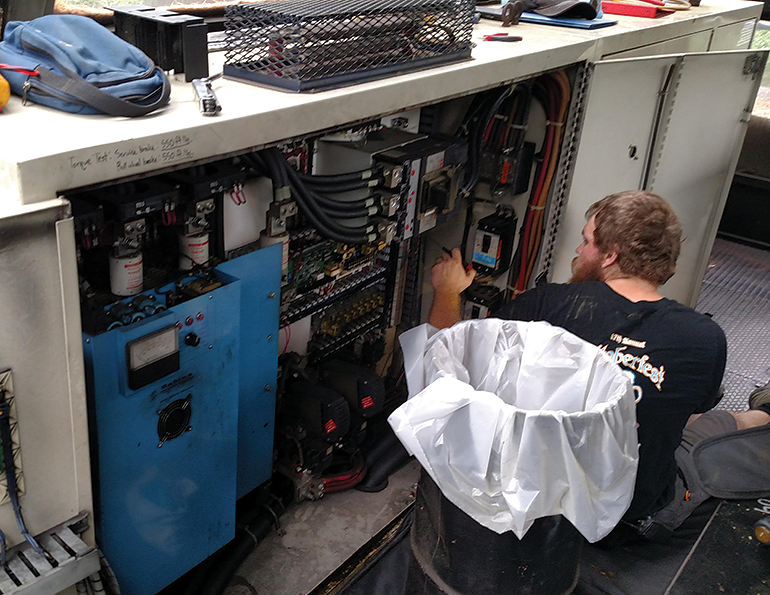 AP Electrical replaced an old Sabina analog drive with an ABB digital DCS800 drive on the Abenaki Quad at Attitash, N.H.
AP Electrical replaced an old Sabina analog drive with an ABB digital DCS800 drive on the Abenaki Quad at Attitash, N.H.
For example, CTEC used Caterpillar planetaries for its final drive. With a Caterpillar dealer in every major city, finding parts is relatively easy. However, some parts on CTEC lifts from the early- to mid-’80s—like the Cat Shaft, which connects the gear box to the final drive—are becoming harder to find through Caterpillar. Consider, too, that some Caterpillar dealers are less familiar with the use of their equipment on ski lifts. (“Buddy, we’ve never made ski lifts,” laughed a salesperson when I once called about parts.)
Chairs and grips. Your annual NDT tests should give you an idea of the condition of your chairs and grips. Comparing NDT reports from past years will tell you if you are starting to see an increase in failures. There are several possible causes of failures: Rope twist could be wearing the grip jaws, seized line gear could be rattling the chairs excessively when they pass over a tower, or the components may be reaching the end of their service life.
Based on manufacturer recommendations, a certified welder can usually repair chair welds. Grips can often be replaced, depending on availability. However, this can be an expensive option that may only make sense if you plan on operating the lift for many more years. In your cost-benefit analysis, this could be the deciding factor to replace rather than repair a lift.
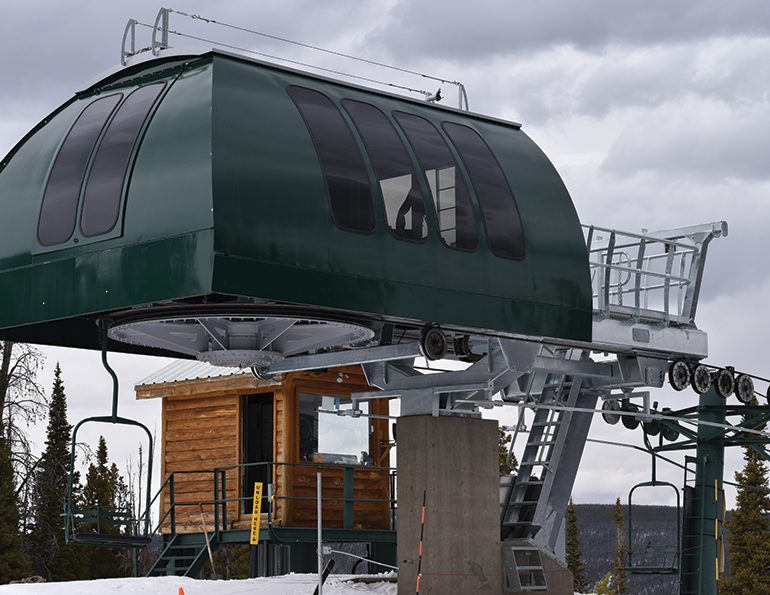 Snowy Range, Wyo., installed a new Skytrac terminal but kept the lift’s original Riblet sheaves, towers, and chairs.
Snowy Range, Wyo., installed a new Skytrac terminal but kept the lift’s original Riblet sheaves, towers, and chairs.
Terminal alignment. Beware of excessive grip-jaw wear on an entire lift—this is often a sign of excessive rope twist. To extend the life of your rope and grips, be sure to address any rope twist when discovered. Misalignment between bullwheel liners and guide sheaves will cause rope twist, so schedule regular inspections of the terminal alignment. The time and materials cost required to perform terminal alignment—and eliminate rope twist—is minor compared to replacing an entire line of grips. Rebuild your first and last tower sheave trains when necessary and make adjustments to minimize the wear of the rubber liners.
Line gear. While line work is a major component of summer lift maintenance, a lot of older lifts in operation are ready for some extensive rebuilds of their line gear—which can be a major undertaking. Bushings are generally easy to source, but pivot shafts and axles can be more difficult to find. Keep spares of these parts on hand to make maintenance easier when necessary.
Greasing the sheave train pivots and replacing worn sheave wheels is common practice at all ski areas. Evaluating sheave train bushing wear, though, is more complex and time consuming. For example, needing to adjust the line gauge—i.e., the need to move an entire assembly in or out from centerline—is not a symptom of normal bushing wear, and indicates other problems that will require evaluation by a surveyor, and maybe an engineer as well.
Issues with these various mechanical systems and components can be addressed individually; on its own, no single problem will condemn a lift to replacement. But as a lift ages, you generally start to see problems occurring with multiple components at once.
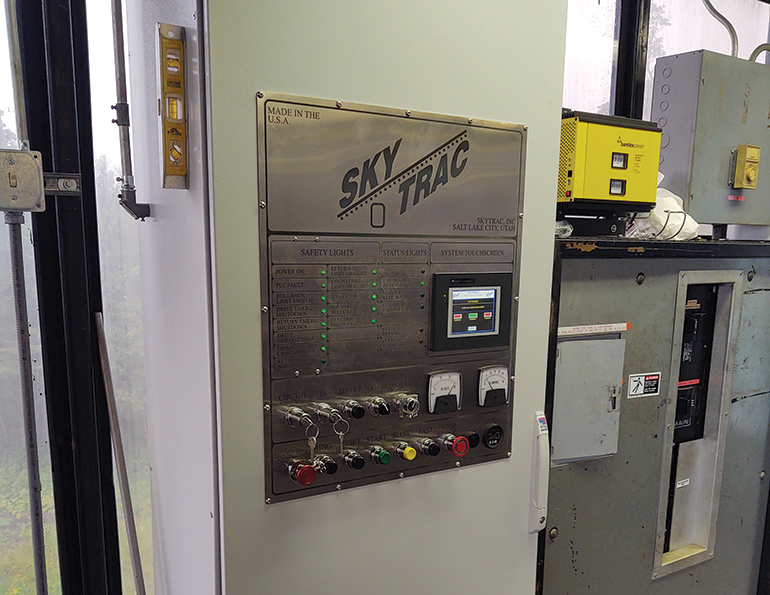 A retrofit of a Yan fixed-grip at Mount Snow, Vt., included a new standalone ABB DCS 880 drive (not pictured) and a low voltage safety control from Skytrac.
A retrofit of a Yan fixed-grip at Mount Snow, Vt., included a new standalone ABB DCS 880 drive (not pictured) and a low voltage safety control from Skytrac.
The maintenance required to keep an older lift functioning safely increases over time and can become a burden. The cost of keeping the lift operational begins to increase, too, and the decision to replace or upgrade starts to become the more obvious solution.
Recordkeeping. When assessing a lift’s systems, it helps to be organized and thorough in order to keep track of everything. Look at each system individually to identify areas of the lift that need attention, and list the upgrades and maintenance required for each system to give yourself a clear understanding of the lift as a whole. The needs of the lift—and your budget—will ultimately determine next steps.
MAKING A DECISION
If an aging lift is adequate in its current capacity and alignment and has no safety issues, there are many options available to extend its useful life. In-house maintenance can restore most systems, and many manufacturers and independent contractors offer electrical or mechanical upgrades, too.
Annex J. With any upgrade, it is important to be aware of the 2017 ANSI B77 Annex J, which outlines new safety necessities for lift electrical systems. The 2017 code requires all new lifts and relocations to meet the Annex J requirements. (Under normal circumstances, the code does not require an existing lift to be brought to up to Annex J standards.) Most states and the U.S. Forest Service have adopted the 2017 ANSI Code and require Annex J safeties for lift installations, relocations, and some retrofits. Discuss your obligations with your governing body, insurance company, manufacturer, and contractor when deciding how to go about an upgrade, retrofit, refurbishment, or replacement.
Regardless of your local requirements, there are plenty of reasons to upgrade to a system that adheres to Annex J. The new requirements increase the redundancies of the safety systems, making lifts safer for your guests and employees. Additionally, upgrading also protects against the possible need for a new system later in the life of the lift should you choose to relocate that lift or perform a major retrofit in the future.
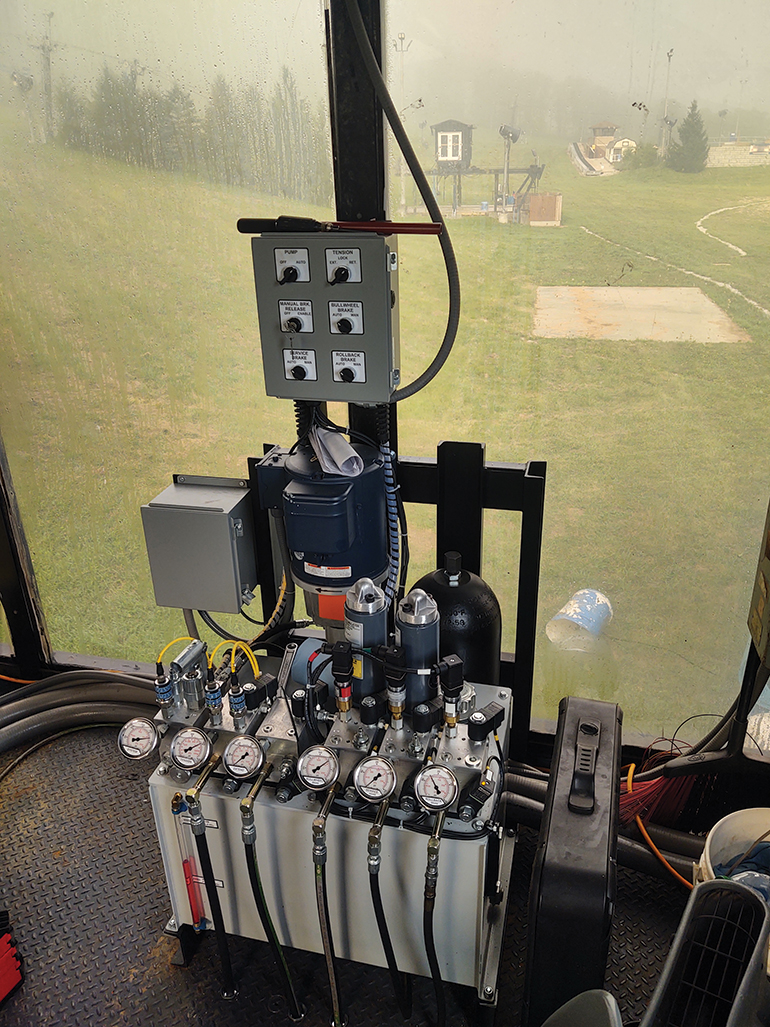 A hydraulic unit installed in an old Riblet at Perfect North Slopes, Ind., as part of a lift upgrade that included a new ABB ACS 880 drive from Skytrac.
A hydraulic unit installed in an old Riblet at Perfect North Slopes, Ind., as part of a lift upgrade that included a new ABB ACS 880 drive from Skytrac.
Upgrade or replace? Some upgrades offer solutions to many systems of a lift at once, says Carl Skylling, president of Skytrac Services. “We can come in and put a new [drive-tension] terminal in an old lift and get rid of a large percentage of your current concerns with new controls, safeties, and brakes,” he says. A solution such as this can address many problems at once and turn your older lift into one that is better supported with parts and service.
If replacement is the best option, do you purchase a new or a used lift? New lifts offer the latest in technology, comfort, and manufacturer support, but come with the steepest price tag.
Used lifts are less expensive up front and can still provide a viable solution to your needs, but there are other considerations to ponder.
To start, it’s important to consider whether the used lift is supported. And in most states, a relocated used lift will need to meet Annex J requirements, which will increase the cost. Depending on the lift’s individual needs, that may make a used lift less cost effective compared to buying new. If it is still a viable option price-wise, though, upgrades to many of the lift’s vital systems will ensure the longevity of the installation.
Bottom line. To make the best decision for your old lift, you will need a full portrait of the lift itself. Are the parts still available? Is there electrical support for the drive or control system? Are the tools required to maintain it available and in working order? What retrofits or upgrades are available to make it more reliable?
You will also need to consider the big picture needs of your ski area. Will a new lift offer a new configuration? Does building a new lift present the opportunity to redesign your base area? Will it allow you to open up new terrain, or offer greater reliability, comfort, or capacity?
The list goes on, but all these factors need to be considered when assessing your aging lift infrastructure and the possibilities for moving forward.





